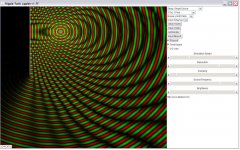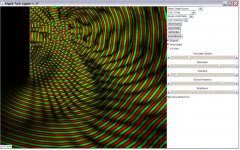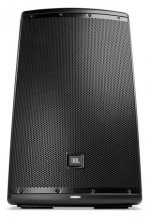Of course the level of reflections (depending on distance from loudspeaker and loudspeaker distance from room surfaces and furnishings), *should* counter this to some extent, but I seriously doubt it's enough to achieve a "flat" response at the listening position.. and likely not even enough to achieve a more common "power response" at the listening position.
why not? I always thought that the level of the reflected sound could easily reach the level of the direct sound
I've found that with eq for flat, the effect persists.
...
Note that the Gradient isn't like this:
Gradient Helsinki 1.5 loudspeaker Measurements | Stereophile.com
Which tends to support the notion that it isn't totally about freq. response attenuation at higher freq.s..
relative - in comparison to the level of the reflected sound, in case of Helsinki - the ceiling reflected sound
Something I've been thinking about is my description of "diffraction effect".
As I think back, I've never tried this with a "blocker" that only provides substantial absorption in the targeted bandwidth.
worth trying
yet another way in which such a diffractive object affects the direct sound can be a certain amount of delay especially when the object is relatively big and close to the source, perhaps this matters too
Last edited:
^
If you put two speakers close together and record them with a stereo mic (what kind? what technique?) and listen to it over speakers, the result will never show anything useful let alone proof for totally unexplored ideas like "spl gradient".

Now this explains a lot
That has always been my suspicion as well, but I never knew for sure. But yes, it explains a lot.
That has always been my suspicion as well, but I never knew for sure. But yes, it explains a lot.
Of course you have, I mentioned it before to you.
why not? I always thought that the level of the reflected sound could easily reach the level of the direct sound
relative - in comparison to the level of the reflected sound, in case of Helsinki - the ceiling reflected sound
yet another way in which such a diffractive object affects the direct sound can be a certain amount of delay especially when the object is relatively big and close to the source, perhaps this matters too
I once did some measurements with radial speakers.. in many cases with several different applications they did not generate sufficient intensity with reflections to off-set the direct sound's loss in pressure. It's certainly not always true though - particularly if the attenuation wasn't to severe and if placed close to one or more boundaries (usually walls).
In fact with the design I was doing at the time (radial), I moved over to a dipole tweeter (Neo 8) to get the response right (..the mid. was still radial however). I don't like "main" speakers next to the walls however (..any wall). The very best surround speakers I've ever done however were "on-wall", AND up-firing radial (sconce-like) - and while the result was quite "hashy", the average level up to about 8 kHz was pretty good. "Full-range" radials for surround speakers is something that others should really try-out (if they are into multi-channel) - highly recommended (particularly when you "multiply" the side-channels by using a digital crossover with delay).
But the loss in pressure, because of distance to the ceiling is fairly substantial for the Gradient's. (..and the Gradient's aren't exactly tall loudspeakers, and they are of the "point-source" variety.)
The delay characteristic is something suggested by ASW research, but even there - they really aren't going below 20 ms delay for the most part, and most near boundary first-order reflections (that might have significant pressure) aren't going to be that long in duration in most domestic settings.
Last edited:
A "sweep" signal and the resulting interference pattern, due to a single adjacent wall.
The interference pattern actually moves with frequency.
Since the pictures are just snapshots in time, that effect is resembled by the curved
shape of the zones of destructive interference.
1. picture: Single point source
2. picture: 3 point sources ("lateral array")
A listener could be imagined e.g. in the lower left of the picture.
The interference pattern actually moves with frequency.
Since the pictures are just snapshots in time, that effect is resembled by the curved
shape of the zones of destructive interference.
1. picture: Single point source
2. picture: 3 point sources ("lateral array")
A listener could be imagined e.g. in the lower left of the picture.
Attachments
Last edited:
Another recent example is the JBL EON615
The 15" is probably used very high, like 2kHz, so they had to do "something" to widen directivity...
An externally hosted image should be here but it was not working when we last tested it.
And to look "cool". Never underestimate that. Look at the throat in their new statement monitors- diffraction party, and completely unnecessary compared to an OS throat. But they look cool.
JBL once was an example of how things should be done (not always, but they earned their place). Now....
They're a great example of why multinationals are not healthy.
And to look "cool". Never underestimate that.
I was going to say exactly the same thing. Everyone assumes that these things are done for solid technical reasons - that couldn't be more wrong.
And to look "cool". Never underestimate that.
And they are just doing it to look cool. Here is what they look like with the steel mess covers in place as in what they look like when you use or purchase them. Don't look very note worthy to me? So I guess they are just wasting money on the cool factor you can't see?
Rob
Attachments
Last edited:
Another recent example is the JBL EON615
The 15" is probably used very high, like 2kHz, so they had to do "something" to widen directivity...
An externally hosted image should be here but it was not working when we last tested it.
I know this kind of difraction device works well in widening the radiation pattern. I have done very similar myself long time ago. This is a good method if wide radiation is what you need.
.
The only problem with such kind of slot loaded woofers is, that it makes up a helmholtz resonator by enclosing a volume behind the slot.
It has to be used sufficiently below that resonance, at least if the driver is assumed to act (like) pistonic there.
On the other hand, with such a large bass driver possibly used in the Khz Region - i could not find the manufacturer's crossover frequency - cone breackup could even mitigate excitation of that helmholtz resonance.
Could be be a beneficial fusion of of two things regarded as being nasty otherwise ...
Nevertheless looks a bit like a "coarse" PA-Concept to me. Using 2 smaller woofers - potentially in 2.5 way
configuration - or going 3-way, would be the more expected way to go in a high quality system.
It has to be used sufficiently below that resonance, at least if the driver is assumed to act (like) pistonic there.
On the other hand, with such a large bass driver possibly used in the Khz Region - i could not find the manufacturer's crossover frequency - cone breackup could even mitigate excitation of that helmholtz resonance.
Could be be a beneficial fusion of of two things regarded as being nasty otherwise ...
Nevertheless looks a bit like a "coarse" PA-Concept to me. Using 2 smaller woofers - potentially in 2.5 way
configuration - or going 3-way, would be the more expected way to go in a high quality system.
Last edited:
Nevertheless looks a bit like a "coarse" PA-Concept to me. Using 2 smaller woofers - potentially in 2.5 way
configuration - or going 3-way, would be the more expected way to go in a high quality system.
In other words - for example does Tannoy Westminster Royal SE look a bit like a "coarse" PA-Concept to You? JBL 4430/5? Tannoy System 15DMT? Are/were these low quality systems?
And to look "cool". Never underestimate that. Look at the throat in their new statement monitors- diffraction party, and completely unnecessary compared to an OS throat. But they look cool.
I don't think so.
Here is an interesting quote from Charles Sprinkle who designed the M2 horn, taken from an interesting mixonline.com article about the JBL M2:
The second thing we did was use a blending geometry—there are no straight lines, you’ll notice—that has a generally decreasing radius,” he continues, “forming an infinite number of reflections, and the net effect is that it smears the reflections coming back down the horn and negates them.
I think the same logic applies here, to a lesser degree: the pattern probably smears diffraction.
Last edited:
This is an entry-level design, with a tiny compression driver (probably 2414H)Nevertheless looks a bit like a "coarse" PA-Concept to me. Using 2 smaller woofers - potentially in 2.5 way
configuration - or going 3-way, would be the more expected way to go in a high quality system.
former model (eon515) crossover was set at 2.2kHz:
https://www.jblpro.com/ProductAttachments/DOC_1190.pdf

Last edited:
I don't think so.
Here is an interesting quote from Charles Sprinkle who designed the M2 horn, taken from an interesting mixonline.com article about the JBL M2:
I think the same logic applies here, to a lesser degree: the pattern probably smears diffraction.
This resembles Onkyo GS-1's "horn having continuously changing cross section" concept.
In other words - for example does Tannoy Westminster Royal SE look a bit like a "coarse" PA-Concept to You? JBL 4430/5? Tannoy System 15DMT? Are/were these low quality systems?
The issue was crossing a 15" woofer > 2Khz in the JBL EON Series, which may be due to saving cost in the tweeter's compression driver and horn.
The systems you mentioned AFAIK cross one full octave lower, which changes things a lot. Nevertheless i regard even those systems you mentioned as "overstretched". Neither the Tannoy systems - especially with larger Coax drivers - nor the JBL 4430 could ever fully convince me in terms of "transparency" or "low coloration".
But - frankly speaking - the Tannoy systems are rated much much lower on my personal scale.
Last edited:
- Status
- This old topic is closed. If you want to reopen this topic, contact a moderator using the "Report Post" button.
- Home
- Loudspeakers
- Multi-Way
- What is the ideal directivity pattern for stereo speakers?



